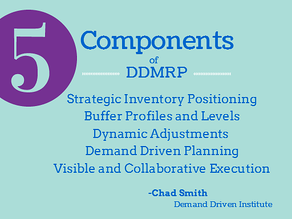Chad Smith is the co-author of the third edition of Orlicky’s Material Requirements Planning 3/E (Ptak and Smith, McGraw-Hill, 2011) and the co-author of Demand Driven Performance – Using Smart Metrics (Smith and Smith, McGraw-Hill, 2013). He is a co-founder and Partner at the Demand Driven Institute, an organization dedicated to proliferating demand driven methods globally. Smith serves as the Program Director of the International Supply Chain Education Alliance’s Certified Demand Driven Planner (CDDP) Program. Clients, past and present, include Unilever, LeTourneau Technologies, Boeing, Intel, Erickson Air-Crane, Siemens, IBM, The Charles Machine Works (Ditch Witch) and Oregon Freeze Dry. Chad is also a certified expert in all disciplines of the Theory of Constraints studying directly under the tutelage of the late Dr. Eli Goldratt. 
Earlier this month Smith, along with Ultriva founder, Narayan Laksham, discussed the five components of DDMRP (Demand Driven Materials Resource Planning) at a well-attended webinar. There are five components of DDMRP. Smith noted that all five of these components are sequential and all are necessary for DDMRP to produce its full impact. The five steps are:
- Strategic Inventory Position
- Buffer Profiles and Levels
- Dynamic Adjustments
- Demand Driven Planning
- Visible and Collaborative Execution
The market, product structure, resource and supplier base must be considered together. Smith suggested that there are several factors to consider. Customer Tolerance time is the time the market is willing to wait before it goes somewhere else. Market Potential Lead Time is the lead time that the market will reward you with more business or a higher price. The level of supply and demand variability must be considered throughout the system. Shared componentry and the total parent-child relationships must be considered along with the structure of the Supply and Distribution net. Finally, any critical resources that must be protected from shortages or disruption must be considered.
Failure to properly position inventory is a huge source of waste for most manufacturing and supply chain companies. Once a company or supply chain knows where to place inventories, those position levels must be set. DDMRP groups these strategic parts and SKU by like attributes. These attributes are typically by lead time whether the parts are made, bought or distributed, how variable they are and if there are significant minimum order quantities. The group profiles are then combined with unique individual part traits to come up with a level. These part specific traits are rate of use (average daily usage), the actual lead time, any specific ordering policies, and for distributed parts the location. DDMRP then uses a 5 zone color system to manage these levels. Light blue meaning over-stocked, green meaning no planning action required, yellow meaning the rebuild zone, red meaning a dangerous situation and deep red meaning out of stock.
Smith noted that once a manufacturer or supply chain manager has determined where to place inventory and what the levels and zones of those positions should be, the next step is to make sure that they can adjust to changes that happen naturally (or planned changes.)
DDMP provides a recalculated adjustment. The buffer flexes as demand changes up or down. This recalculation occurs through a rolling horizon. The length of that horizon is situational. There are also planned adjustments. Planned adjustments are predictable events in the supply chain process, such as seasonality. Companies also introduce a product where market roll-out or acceptance may be staged. Similarly companies decide when a product or part is going to be discontinued and want to prevent large obsolete quantities.
These are just some of the important items discussed in the DDMRP Ultriva webinar.



